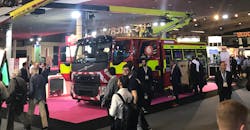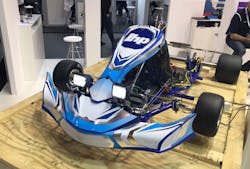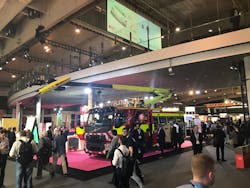At the recent fourth IoT World Congress (IOTSWC) in Barcelona, there were many large manufacturers present showing off what they can do with technology. There will be more coverage on a later blog, but a few solutions in the IoT automotive space deserve to be noted here. There was a small, unsuspecting go-kart and a large, dominating firetruck at the event, neither of which you’d typically find at an expo. However, that’s what I’ve come to expect at the IOTSWC: solutions, not norms.
What is a Smart Headlight?
The make-everything-smart trend is getting out of hand. Approaching a small go-kart at the event, one might suspect a conversation around an SME race, such as Baja or Formula One. Instead there was a conversation about Morse Code and smart headlights. Whoever thought a series of dashes and dots would still be relevant today? well, it’s not that simple.
The go-kart’s lights were actually being pulsed or modulated to communicate with cameras. A human eye sees nothing but a continuous bright light. However, with an app and camera, such as the one on a smartphone, it is apparent that the go-kart is actually sending data while lighting the way. Dirar Hakeem, a project management professional and Cisco Certified Internetwork Expert at AASA Inc., held up a smartphone; when passed over the headlights the data started to flow: fluid levels, performance information breaking, acceleration, etc.
The headlights have filters over them because they were so bright, but even dimmed the data was unaffected.
With many companies working on autonomous vehicles, this technology could help vehicles communicate with each other, and anything else that is in the line of sight—tollbooths, emergency crews, etc. AASA, a U.S. based IT, engineering, and R&D solutions provider, leading through its 01LightCom subsidiary, has recently joined the Industrial Internet Consortium (IIC), the world’s leading organization for transforming business and society by accelerating the adoption of the Industrial Internet of Things (IIoT). AASA is the first IIC member to introduce the visible light communication (VLC) technology and Li-Fi.
What is Li-Fi?
On the AASA’s website, the company explains how VLC offers high bandwidth, immunity to interference from electromagnetic sources, and high levels of communications security. In addition, the latest advances in the field of solid-state lighting and the inevitable replacement of florescent lighting by Light Emitting Diodes (LEDs), facilitates the deployment of VLC technology. The combination of bidirectional VLC with LEDs is referred to as Li-Fi.
The technology is in the drive, so any LED can be turned into a communication device: city street lamps, headlights, and even the light on your smartphone. VLC addresses the shortcomings of current localized wireless communications. The Radio Frequency (RF) communication suffers from interference, limited bandwidth, and security issues. In addition, RF communication requires a separate setup for transmission and reception of RF waves, at the cost of higher energy consumption. Finally, the limited RF spectrum is unable to meet the demand for ubiquitous low energy and high-capacity connectivity, which is necessary for an efficient implementation of the Internet of Things (IoT/IIoT).
VLC systems can employ the entire range of the visible light spectrum in the implementation of visible light-enabled communication. The low bandwidth problem of RF communication is resolved in VLC by means of large bandwidth availability (more than 10,000 times larger than the bandwidth of RF spectrum). VLC is a promising technology featuring non-licensed channels, high bandwidth, and low power consumption.
What’s a Smart Firetruck?
The next IoT solution at the show wasn’t as hidden: Parked right in the middle of the event space was a big red firetruck. It was the third test bed at IOTSWC. A smart fire truck developed by Emergency One together with Vodafone, it was equipped with a set of solutions that allow for the automation of a series of tasks in the control panel. While RFID tags, sensors, and hardware ensured all the vital equipment is on board, water sensors measure tank capacity and how much water was used in an incident.
As just one of the test beds, the connected firetruck proves that is it’s necessarily about the technology but how you use it to solve a problem that will yield new innovations.
The vehicle can also report when the blue lights and sirens are on, ensuring that the teams are covered from an insurance perspective. When required, the data collected from all the sensor points on the vehicles means a post-event report can be created centrally showing who was on board, how long an incident was attended for, and other data required.
Emergency One has established a key set of requirements that rescue workers need. As such the dashboard within its fire engines can now be configured to carry out a number of tasks automatically. If vehicles also had the Li-Fi technology on board, it could alert drivers that there is an emergency vehicle trying to get through even if the radio is up and they aren’t paying attention to their mirrors. If technology like this could be adopted in all vehicles, perhaps sirens and lights will not have to be so loud or bright, helping to quiet city environments.
Connected equipment can help mitigate paper work, and present more accurate reports. This is providing management with better data to develop training programs, and give firefighters more time for that training.
Autonomous cars will take multiple technologies, and these early adopters will help integrate technologies that might aid in communication to make robust and redundant system to ensure safety on the road.





